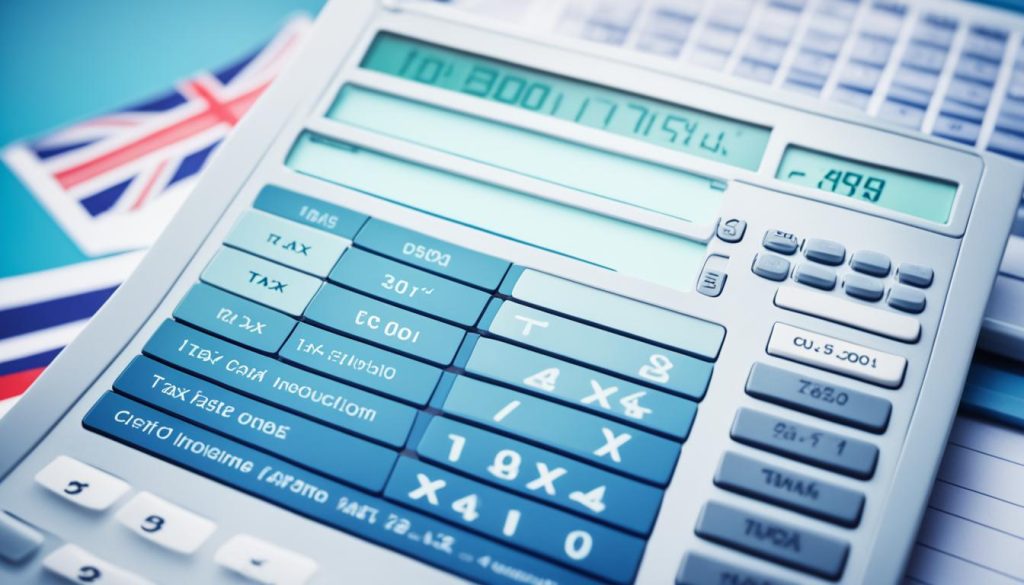Are you wondering how much tax you’ll have to pay in the UK? Whether you’re a PAYE taxpayer, self-employed individual, or have multiple jobs, it’s crucial to understand your tax obligations. Knowing the amount you’ll be taxed can help you plan your finances and ensure you’re prepared for any tax liabilities that may arise.
One of the easiest ways to estimate your tax payments is by using the HMRC tax calculator. This online tool takes into account your income, personal allowance, and tax rates to provide you with an estimate of how much Income Tax and National Insurance you should pay for the current tax year. It even considers any deductions or reliefs you may be eligible for, giving you a comprehensive overview of your tax liability.
Please note that the HMRC tax calculator is helpful for most individuals, except for those with income solely from self-employment or state benefits, as well as individuals repaying student loans. However, for the majority of taxpayers, this tool is a valuable resource for understanding their tax obligations and planning their finances accordingly.
In addition to Income Tax, it’s important to consider other taxes, such as National Insurance Contributions (NICs) and Value Added Tax (VAT). NICs are contributions made by individuals to access certain state benefits, including the State Pension and healthcare. The amount you pay depends on your income and employment status.
VAT, on the other hand, is a consumption tax added to the price of most goods and services in the UK. The standard rate is currently 20%, but there are reduced rates for certain items. Understanding how these taxes work will help you calculate your overall tax liability more accurately.
By taking advantage of tax planning tools and understanding the different tax brackets, you can optimize your financial situation and ensure you’re paying the right amount of tax while maximizing your personal allowance. If you need further assistance, consulting with an accountant can provide valuable insights tailored to your specific circumstances.
So, don’t let tax calculations overwhelm you. With the help of the HMRC tax calculator and other tax planning tools, you can gain a better understanding of how much tax you’ll pay and plan your finances accordingly. Stay informed and make the most of your tax situation!
Understanding Income Tax in the UK
Income tax in the UK is calculated based on various factors, including your income and the tax bands. To better understand how much tax you’ll be paying, it’s important to familiarize yourself with the income tax rates, personal allowance, income tax brackets, and the use of a tax calculator. Let’s explore these key aspects in more detail:
Current Tax Year and Personal Allowance
The current tax year in the UK runs from April 6, 2023, to April 5, 2024. It’s essential to stay updated with the tax regulations and rates applicable during this period. One vital component to consider is the personal allowance, which determines the amount of income you can earn before you start paying income tax.
The standard Personal Allowance for this tax year is £12,570. This implies that the first £12,570 of your income is exempt from income tax. The Personal Allowance acts as a tax-free threshold, reducing the amount of taxable income. It’s worth noting that personal allowances may vary based on individual circumstances.
Income Tax Rates and Brackets
Once your income exceeds the Personal Allowance, you’ll be subject to income tax. The income tax rates in the UK are divided into different tax bands, each with its corresponding tax rate. Below are the income tax rates for the current tax year:
- 0%: Applies to income up to £12,570 (Personal Allowance).
- 20%: Applies to income between £12,571 and £50,270 (basic rate).
- 40%: Applies to income between £50,271 and £125,140 (higher rate).
- 45%: Applies to income over £125,140 (additional rate).
It’s important to determine which tax bracket your income falls into to calculate your income tax. Remember, the income tax rates mentioned above are based on the current tax year and may vary if you live in Scotland.
Using a Tax Calculator
Calculating your income tax manually can be complex, given the various factors involved. Thankfully, there are tax calculators available that simplify the process and provide accurate estimates of your tax liability. A tax calculator takes into account your income, personal allowance, and tax rates for each income bracket to give you an idea of how much tax you’ll be paying.

By using a tax calculator, you can gain a better understanding of your tax obligations and plan your finances accordingly. It’s a useful tool for both individuals and businesses to estimate their tax liability and make informed decisions.
National Insurance Contributions in the UK
National Insurance (NI) is a contribution made by individuals in the UK to access certain state benefits, such as the State Pension and healthcare. The amount you pay depends on your income and employment status.
The NI rates for the current tax year are:
- 0% on income up to £9,568
- 12% on income between £9,568 and £50,270
- 2% on income above £50,270
If you’re self-employed, you’ll also need to pay NI Class 2 contributions of £159 per year.
To estimate your NI contributions, you can use a tax estimator tool or consult with a tax planning professional. This will help you plan your finances and ensure you’re aware of your contribution obligations.

Understanding National Insurance in the UK
When it comes to National Insurance in the UK, it’s important to understand how it works and how it affects your overall tax liability. National Insurance contributions not only provide access to important benefits but also play a fundamental role in funding the welfare system.
Employed individuals typically pay Class 1 National Insurance contributions through their paychecks, while self-employed individuals make separate contributions through their annual self-assessment tax return.
In addition to contributions based on your income, your employment status also affects the amount you pay. For example, if you’re employed, your employer will deduct National Insurance contributions from your salary. However, if you’re self-employed, you’re responsible for calculating and paying your own contributions.
Considering the complexity of National Insurance contributions, using a tax estimator tool can be highly beneficial. This tool takes into account your income and employment status, providing an accurate estimate of the National Insurance contributions you’ll need to make.
By utilizing a tax estimator tool and seeking advice from a tax planning professional, you can ensure you have a clear understanding of your National Insurance obligations and incorporate them into your overall tax planning strategy.
Value Added Tax (VAT) in the UK
Value Added Tax (VAT) is a consumption tax that is added to the price of most goods and services in the UK. It plays a significant role in the country’s revenue generation and social welfare funding. Understanding VAT rates and calculations is crucial for both individuals and businesses to ensure compliance and accurate financial planning.
VAT in the UK is charged at different rates, with the standard rate currently set at 20%. However, there are reduced rates of 5% and 0% for specific goods and services. The reduced rate of 5% is applicable to certain essential items such as food, children’s clothing, and energy-saving equipment. The 0% rate applies to goods like books, newspapers, and children’s clothing.
Businesses in the UK are required to charge VAT on their taxable supplies and subsequently pay the collected VAT to HM Revenue and Customs (HMRC). The VAT liability for businesses depends on various factors, including their VAT registration status, the type of goods or services provided, and any applicable exemptions or reliefs.
Calculating VAT liability can be complex, particularly for businesses with diverse transactions. Thankfully, there are resources available to simplify this process. Business owners can utilize tax liability calculators or engage the services of experienced accountants to ensure accurate VAT calculations.
Here is a comprehensive table highlighting the different VAT rates in the UK:
| VAT Rate | Description |
|---|---|
| 20% | The standard rate of VAT applies to most goods and services that don’t qualify for reduced rates. |
| 5% | A reduced rate applicable to certain essential items such as food, children’s clothing, and energy-saving equipment. |
| 0% | The zero rate applies to goods such as books, newspapers, and children’s clothing. |
Utilizing a tax liability calculator can greatly assist businesses in accurately determining their VAT liability. These tools consider the specific VAT rates and exemptions applicable to each transaction, simplifying complex calculations and ensuring compliance with VAT regulations.
In conclusion, Value Added Tax (VAT) is an essential component of the UK’s tax system. Understanding VAT rates, calculations, and VAT liability is crucial for individuals and businesses alike. By utilizing tax liability calculators or seeking professional advice, businesses can accurately calculate their VAT liabilities and ensure compliance with VAT legislation.
Other Taxes to Consider
In addition to income tax and National Insurance, individuals in the UK may also need to be aware of other taxes that can impact their financial obligations. Understanding these taxes is crucial for effective financial planning. The following are some key taxes to consider:
1. Stamp Duty
Stamp duty is a tax levied on the purchase of property in the UK. The amount of stamp duty payable varies based on the value of the property. It’s important to factor in stamp duty costs when budgeting for a property purchase.
2. Inheritance Tax
Inheritance tax (IHT) is a tax imposed on the estate of a deceased individual. The tax rates and thresholds for inheritance tax vary depending on the relationship between the deceased and the beneficiary. It’s essential to understand the rules and exemptions surrounding inheritance tax to plan your estate effectively.
3. Capital Gains Tax
Capital gains tax (CGT) is applicable when you sell certain assets for a profit, such as property or investments. The tax rate for capital gains tax depends on various factors, including your income and the type of asset being sold. It’s important to calculate your potential capital gains tax liability to ensure compliance with tax regulations.
4. Council Tax
Council tax is a local tax imposed on residential properties in the UK. The amount of council tax payable is determined by the value of the property and its designated council tax band. It’s essential to understand the council tax banding system in your area and budget for council tax payments.
Being aware of these additional taxes and their implications is vital for effective financial planning and ensuring compliance with tax obligations. For more detailed information and personalized advice, consulting with a tax professional is recommended.

Using Tax Planning Tools
Tax planning is crucial for individuals to effectively manage their tax liabilities and optimize their financial situation. By utilizing tax planning tools, individuals can gain valuable insights into their tax liabilities and make informed decisions to minimize their tax burden. Two essential tax planning tools that can assist in this process are tax calculators and tax estimate calculators.
1. Tax Calculators
A tax calculator is a powerful tool that enables individuals to estimate their tax liability based on their income, deductions, and personal circumstances. By inputting accurate information, such as income sources, allowances, and tax reliefs, individuals can obtain an estimate of the amount of tax they are likely to owe.
Using a tax calculator provides several benefits:
- Accurate Estimates: By considering multiple variables, including income levels, taxable benefits, and allowable deductions, tax calculators offer accurate estimates of tax liabilities.
- Scenario Planning: Tax calculators allow individuals to experiment with different scenarios by adjusting income levels or exploring potential tax-saving opportunities. This empowers individuals to make informed decisions to minimize their tax burden and maximize tax efficiency.
- Time-Saving: Tax calculators eliminate the need for manual tax calculations, saving individuals time and effort.
To access a tax calculator UK, individuals can visit reputable websites offering tax planning tools or consult with a qualified tax professional.
2. Tax Estimate Calculators
A tax estimate calculator is a useful tool for individuals who want to assess their tax liability throughout the tax year. This tool takes into account periodic income, expenses, and changes in personal circumstances to provide accurate estimates of tax owed. By regularly using a tax estimate calculator, individuals can proactively plan for their tax obligations and make necessary adjustments to their financial management strategies.
Key advantages of tax estimate calculators include:
- Real-Time Updates: Tax estimate calculators can account for changes in income or expenses throughout the tax year, providing up-to-date and accurate tax liability estimates.
- Year-End Planning: By having access to estimated tax liabilities in real-time, individuals can proactively plan for any additional tax payments or adjust their financial strategies to optimize tax savings.
- Streamlined Record-Keeping: Tax estimate calculators help individuals maintain accurate tax records by tracking income, expenses, and potential deductions. This simplifies the tax filing process and ensures compliance with HMRC regulations.
It’s important to note that while tax calculators and tax estimate calculators provide valuable insights, consulting with a tax professional can offer personalized advice tailored to an individual’s unique circumstances.

| Tax Planning Benefits | Description |
|---|---|
| Minimized Tax Burden | Make informed decisions to reduce overall tax liability. |
| Optimized Financial Situation | Strategically manage income and deductions for increased financial efficiency. |
| Enhanced Tax Efficiency | Utilize available tax reliefs and allowances to minimize tax payments. |
| Better Financial Planning | Understand tax obligations and plan for future payments. |
Conclusion
Calculating and understanding your tax liabilities is crucial for effective financial planning. By utilizing tools like the HMRC tax calculator, you can estimate your tax obligations based on your income and personal circumstances. It is essential to take into account factors such as income tax rates, National Insurance contributions, and other taxes like VAT, stamp duty, inheritance tax, capital gains tax, and council tax.
By employing tax planning tools and gaining a comprehensive understanding of tax brackets, you can optimize your financial situation. This ensures that you pay the correct amount of tax while maximizing your personal allowance. Remember, if you require further guidance, consulting with an accountant can provide valuable insights tailored to your specific circumstances.
Take control of your tax calculations and HMRC tax obligations to secure a solid financial future.















No Comments
Leave a comment Cancel